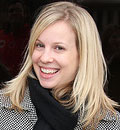Philanthropy411 is currently covering the Communications Network and CommA Fall 2010 Conference in Los Angeles with the help of a blog team, which is part of the conference’s 2nd annual Gorilla Engagement Squad. This is a guest post by Allyson Burns, Director of Communications at The Case Foundation. Follow Allie on Twitter: @allieb37.
by: Allyson Burns
 Reflecting on my experience at this past week’s Communications Network conference, which featured incredible speakers and really insightful conversations, one of the things that continues to strike me is Lucy Bernholz’s discussion of “adjacent possibilities,” during which she encouraged the philanthropy sector to adjust to new and changing models of addressing social challenges. With the rise of B Corporations and other new organizational models like those of Ushahidi and Crisis Commons, what role can we communicators take to encourage the traditional philanthropy sector to embrace and work more closely with these new forms of enterprise to make a bigger impact?
Reflecting on my experience at this past week’s Communications Network conference, which featured incredible speakers and really insightful conversations, one of the things that continues to strike me is Lucy Bernholz’s discussion of “adjacent possibilities,” during which she encouraged the philanthropy sector to adjust to new and changing models of addressing social challenges. With the rise of B Corporations and other new organizational models like those of Ushahidi and Crisis Commons, what role can we communicators take to encourage the traditional philanthropy sector to embrace and work more closely with these new forms of enterprise to make a bigger impact?
Lucy set up the need for adjacent possibilities with a slide that clearly demonstrated how no one sector (public, private, foundations or nonprofits) is equipped to address major social challenges – which, in and of itself isn’t a surprise. However – and I say this as someone who is still a relative newcomer to the philanthropy space – I’m often struck by how challenging it has been for our sector to figure out how we can harness both new and old models to solve big challenges. While Foundations should proudly take credit for doing incredible work, it seems that we often tend to stay within our own silo. Part of this is due to fundamental structure barriers that are somewhat out of our control (highlighted by the Ushahidi example) but I think it may also be because we’re afraid of losing some of the control that current models allow us to have.
As Daniel Silverman of the James Irvine Foundation pointed out in his reflections on the conference, “The communications function in foundations has evolved from a news release and annual report production factory to a strategic partner to help foundations accomplish their missions.” So what can we as communicators do to encourage our leadership to think disruptively? How can we push our space to open up and work together with these new enterprise models – be they B corporations/social enterprises, new forms of nonprofits, etc., in spite of the barriers we face?
Facilitating the use of crowdsourcing, another hot topic at the conference, is one possibility. As this post by Adin Miller and as other fellow CommNet bloggers and tweeters pointed out, truly leveraging the wisdom of the crowds may be a challenge when it comes to finding diverse crowds and making sure we actually leverage the wisdom they provide. But I think we have to start trying. By employing the listening tools that effective crowdsourcing requires, we’ll learn about and be able to elevate new approaches and thinking to our leadership. Crowdsourcing is something that continues to be top of mind for us at the Case Foundation – we began experimenting in 2007 with our Make It Your Own Awards, one of the first public grantmaking programs. Did we get it exactly right? Certainly not – but we’re proud of what we accomplished and that the effort spurred additional experimentation with this model, and we’ve continued to share what we learned and have made a commitment to cultivating additional conversation about crowdsourced models to create more powerful programs that tap into collective wisdom of the crowds.
In addition, we as foundation communicators have a unique platform to highlight and facilitate conversations around issues that we care about. Taking the case of Ushahidi, which couldn’t get traditional foundation funding because it was not a 501(c)(3), or any other “out of the mold” model, we can search for other ways to help these organizations – by spreading the word about their work or identifying partnership opportunities through our various networks.
I’d love to see foundations take the lead in embracing disruptive philanthropy, and push the sector to evolve. How do we as communicators do that? I know that I don’t have all of the answers, but it’s a conversation I’d love to see get started.






